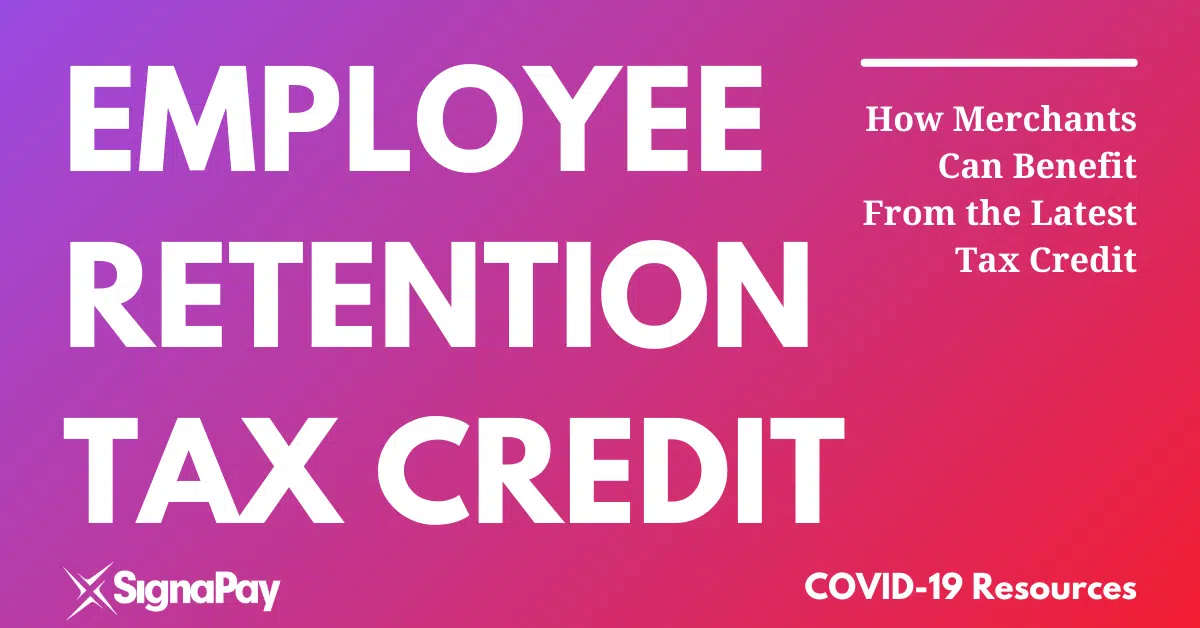Employee Retention Tax Credit: How Merchants Can Benefit From the Latest Tax Credit

For up to date information on the Employee Retention Credit, please visit the IRS at www.irs.gov/coronavirus-tax-relief-and-economic-impact-payments
In 2020, the COVID-19 Pandemic forced many businesses into a situation that posed a great risk to their livelihoods. The federal government, under the CARES Act, is issuing a tax credit to businesses of all sizes that qualify if they retained employees during the pandemic. The Employee Retention Credit (ERC) was meant to incentivize businesses from laying off workers and minimize the amount of workers filing for unemployment benefits. The tax credits that eligible businesses can receive are equal to 50% of qualified wages that eligible employers pay their employees in a calendar quarter. Qualified employers can earn a maximum credit of $5,000 per employee.
Employers, including tax-exempt organizations, are eligible for the credit if they operate a trade or business during calendar year 2020 and experience either:
- The full or partial suspension of the operation of their trade or business during any calendar quarter because of governmental orders limiting commerce, travel, or group meetings due to COVID-19, or
- A significant decline in gross receipts.
- A significant decline in gross receipts begins:
- on the first day of the first calendar quarter of 2020
- for which an employer’s gross receipts are less than 50% of its gross receipts
- for the same calendar quarter in 2019.
- The significant decline in gross receipts ends:
- on the first day of the first calendar quarter following the calendar quarter
- in which gross receipts are more than of 80% of its gross receipts
- for the same calendar quarter in 2019.
- The credit applies to qualified wages (including certain health plan expenses) paid during this period or any calendar quarter in which operations were suspended.
If you received money from a Paycheck Protection Program Loan, your eligibility requirements are different depending on if you have had your loan forgiven or not. Please check with the IRS to determine if this applies to your business. To properly take advantage of these benefits on your business’s taxes, please reach out to your local CPA tax professional.
Key Takeaways:
- The updated Employee Retention Credit (ERC) provides a refundable credit of up to $5,000 for each full-time employee you retained between March 13 and Dec. 31, 2020 and up to $14,000 for each retained employee between Jan. 1 and June 30, 2021.
- You qualify as an employer if you were ordered to fully or partially shut down or if your gross receipts fell below 50% for the same quarter in 2019 (for 2020) and below 80% (for 2021).
- If you were not in business in 2019, you can use the corresponding quarters from 2020.
- You can claim your credit immediately by reducing payroll taxes sent to the IRS.
- If your credits exceed payroll taxes, you can request a direct refund from the IRS.
- The new law, retroactive to March 27, 2020, now allows employers who received Paycheck Protection Program (PPP) loans to claim the ERC for qualified wages not treated as payroll costs in obtaining forgiveness of the PPP loan.
*SignaPay is not a tax preparation service, Certified Public Account or tax professional and the content in this blog does not constitute tax advice. Please visit your local CPA tax professional for tax advice.
Recent blog posts
The latest industry news, interviews, technologies, and resources
SignaPay Celebrates Fourth Appearance on Inc. Magazine’s Inc. 5000 List
FOR IMMEDIATE RELEASE Dallas, TX, August 13, 2024 – SignaPay, a premier provider of innovative payment solutions, is thrilled to announce its inclusion in Inc. Magazine’s prestigious Inc. 5000 list …
Field Sales Training for Merchant Services: Elevate Your Sales Team’s Success
Field sales training is a critical component for any merchant services company, especially one like SignaPay. In the competitive landscape of payment processing, a well-trained field sales team is essential …
Chargeback Fees: How to Help Your Merchants Combat Disputes and Reduce Losses
As a merchant service provider, chargebacks are a common challenge faced by many of your clients, especially those in e-commerce or businesses with high credit card transaction volumes. Chargebacks occur …
Enhance Your Sales Pitch with Mobile Credit Card Processing Solutions
How Mobile Credit Card Processing Can Boost Your Sales Pitch as a Merchant Service Professional As a merchant service sales professional, offering innovative solutions like mobile credit card …